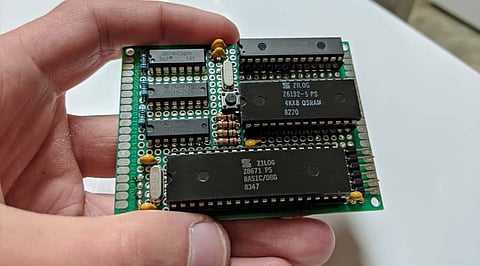

FPGA represents a field-programmable gate array. Basically, an FPGA is a hardware circuit that a user can program to do at least one intelligent activity. Made a stride further, FPGAs are integrated circuits, or ICs, which are sets of circuits on a chip—that is the "array" part. Those circuits, or arrays, are gatherings of programmable logic gates, memory, or other elements.
The FPGA has its underlying foundations in prior devices, for example, programmable read-only memories (PROMs) and programmable logic devices (PLDs). These gadgets could be modified either at the plant or in the field, however, they utilize fuse innovation (thus, the articulation "burning a PROM") and couldn't be changed once programmed. Conversely, FPGA stores its configuration data in a re-programmable medium, for example, static RAM (SRAM) or flash memory. FPGA manufacturers incorporate Intel, Xilinx, Lattice Semiconductor, Microchip Technology and Microsemi.
The FPGA market keeps on booming. As indicated by the worldwide forecast, throughout the next couple of years, its CAGR will be at an average of 8.6%. However, the most fascinating are new appliances of the tech, which are now and again more likened to sci-fi than to reality.
You may utilize an FPGA when you need to enhance a chip for a specific workload, or when you are probably going to have to make changes at the chip level later on. Utilizations for FPGAs cover a wide scope of territories—from equipment for video and imaging, to circuitry for computer, auto, aerospace, and military applications, in addition to electronics for specialized processing and more. FPGAs are especially helpful for prototyping application-specific integrated circuits (ASICs) or processors. An FPGA can be reconstructed until the ASIC or processor configuration is conclusive and bug-free and the actual manufacturing of the final ASIC begins. Intel itself utilizes FPGAs to model new chips.
Intel recently procured an organization called eASIC as an approach to accelerate its planning and prototyping measure. eASIC produces something many refer to as a "structured ASIC," which depends on a model that is in the middle of an ASIC and an FPGA.
The advantages could be simpler deployment and better reconciliation yet the choice to choose the best of every world won't be achievable any more or possibly it will be all the more challenging (for example a choice of FPGA from Xilinx, Intel Xeon Processor and a GPU from Nvidia).
For Intel and AMD it will be difficult to promote FPGAs in the area of deep learning, for instance, while different platforms will be accessible under their own brand name. Perhaps FPGAs will generally be used in their bread-and-butter market (networking and telecom like vRAN and 5G) while different platforms (GPUs, ASICs) will be promoted for deep learning.
FPGA circuits have numerous features that are fitting to the objectives of IoT. They burn-through a bit of power on computations. They're quick and ready to work profoundly simultaneously. They're conservative yet have a lot of I/O ports. Nonetheless, the truth is that most FPGAs are too costly to be implemented into IoT devices.
Several years back FPGA makers started to dispose of that bottleneck. Here are a few of the most simple and cheap models of FPGA. The least expensive to date are the Lattice iCE40 Ultra/UltraLite family and GOWIN GW1NZ-ZV consistently on super low-power FPGA. With a cost coming to as low as a couple of dollars for every piece, such circuits are satisfactory for the IoT devices a bit more advanced than connected light bulbs. In the coming years, the cost will keep on diminishing, while the volume of data will multiply. It implies that the function of FPGA in the realm of IoT will absolutely increment.
The fundamental advantage of FPGAs is the programmability to help tailored-made architectures. This implies that they can adjust a lot quicker to new algorithms or applications. This upper hand is of central significance particularly in the space of deep realizing where new models are created by ML engineers
and data scientists. FPGAs can be programmed with the new custom made model/algorithm and can give better performance compared to other platforms. Particularly in applications where bit-level processing is required, similar to packet processing, genomics and bitcoin mining, FPGAs have indicated much better performance than other platforms. In deep learning applications, FPGAs can give lower latency and performance particularly when the number of bits are used. (for example Xilinx FINN). So it appears to be that FPGAs can have a significant part in the new processing ecosystem and not be utilized uniquely for the SmartNIC applications.
Robotics technology is where FPGA is appropriate the most, and the circumstance will even change to the better through time. A great deal of I/O ports, fast processing, low latency, and high flexibility make FPGA chips truly outstanding here.
An essential pattern of robotics is expanding intricacy. That is to say, most importantly, a developing volume of connected sensors, which require an ever-increasing number of input-output ports. All the data from these sensors must be handled progressively, which requires both high processing speed and high concurrency.
Join our WhatsApp Channel to get the latest news, exclusives and videos on WhatsApp
_____________
Disclaimer: Analytics Insight does not provide financial advice or guidance. Also note that the cryptocurrencies mentioned/listed on the website could potentially be scams, i.e. designed to induce you to invest financial resources that may be lost forever and not be recoverable once investments are made. You are responsible for conducting your own research (DYOR) before making any investments. Read more here.
